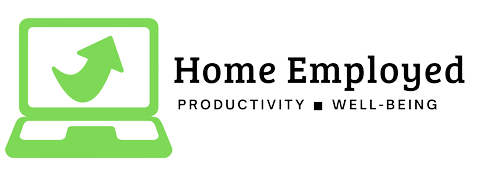Effective break taking methods while working from home have become more and more important in today’s society. Since, working from home (WFH) has become increasingly common in recent years, with many companies and employees finding that it can be an effective way to increase productivity and reduce costs. However, working from home can also be challenging, particularly when it comes to taking breaks.
Without the structure and routine of a traditional office environment, it can be easy to become engrossed in work and neglect to take regular breaks. This can lead to burnout, fatigue, and decreased productivity. Therefore, it is important to establish effective break-taking habits while working from home.
Effective break taking methods like the Pomodoro Technique, the “52-17” rule, and the “20-20-20” rule will enable you to do more all while maximizing your energy and concentration. Such as, taking 20 steps 20 feet away every 20 minutes away from your work to clear your mind and get your blood flowing again. This method will also reduce the strain on your body.

Strategies
While working from home, it is crucial to take effective breaks that keep you productive throughout the day. Here are 3 of the best break taking strategies. The idea is having structure to breaks, and not loosing yourself in time and realize an hour later than you have not accomplished your goals. use these to stay focused on your goals!
1) Pomodoro Method
One of the most effective break-taking methods is the Pomodoro Technique. This technique involves breaking work into 25-minute intervals, called “Pomodoro,” followed by short breaks. After four Pomodoro, a longer break should be taken. This technique is based on the idea that frequent, short breaks can increase productivity and focus by allowing the mind to rest and recharge. It also helps to prevent burnout by ensuring that you take regular breaks throughout the day, making this one of the best practices while WFH.
2) 52-17 Rule
Another effective break-taking method is the “52-17” rule. This rule suggests that you work for 52 minutes and then take a 17-minute break. This technique is based on research that suggests that the optimal work-to-break ratio is 52 minutes of work to 17 minutes of break. This technique allows for longer periods of focused work, followed by shorter breaks that can be used to rest and recharge.
3) 20-20-20 Rule
Another break-taking method that can be effective for working from home is the “20-20-20” rule. This rule suggests that every 20 minutes, take 20 seconds to look at something 20 feet away. This can help to reduce eye strain and prevent fatigue, which can be a common issue when working on a computer for long periods of time.
Moreover, this rule will refresh your mind and body energy. For example, if you spend time on the phone with prospect and clients, consider walking around your home to keep your blood flowing and refresh your mind. Sitting at a desk all day can be draining!
Why take a Break?
In addition to taking regular breaks, it is also important to create a comfortable and ergonomic work environment. This can include setting up your desk and chair to the correct height, keeping your computer screen at the correct distance and angle, and using a comfortable mouse and keyboard. These are just a few of the WFH tools you may need! These small adjustments can help to reduce strain on your body and prevent discomfort, which can make it easier to stay focused and productive.
Taking regular breaks is essential for maintaining productivity and focus. This is backed by research, which has shown that taking breaks can have a number of benefits, including:
- Reducing fatigue: Research has shown that taking regular breaks can help to reduce fatigue and improve cognitive function.
- Improving focus: Taking short breaks can help to improve focus and concentration. Research has shown that the Pomodoro Technique, which involves breaking work into 25-minute intervals followed by short breaks, can be effective in increasing productivity and focus.
- Reducing stress: Taking breaks to engage in activities that are different from work can help to reduce stress and improve overall well-being. Mindfulness practices such as meditation and yoga have been shown to be effective in reducing stress.
- Improving creativity: Research has shown that taking breaks can help to improve creativity and problem-solving skills. Engaging in activities that are different from work, such as reading, listening to music, or engaging in a hobby, can help to refresh the mind and increase productivity.
- Improving physical health: Taking physical breaks can help to reduce discomfort and prevent strain on the body, which can lead to better overall physical health.
- Improving work-life balance: Taking regular breaks can help to maintain a healthy work-life balance and prevent burnout, as shown by research.
In summary, research has shown that taking regular breaks is essential for maintaining productivity and focus, reducing fatigue, stress, and improving creativity, physical and mental health, and work-life balance. It is important to establish effective break-taking habits to ensure that you are able to take regular breaks throughout the day, and to make it a regular part of your daily routine.
What to do During a Break?
Another effective way to take breaks while working from home is to schedule in time for socialization. This can include scheduling a virtual coffee break with a colleague, having a virtual lunch date with a friend, or even just shooting a quick text message to a friend or family member. Socialization can help to break up the monotony of working from home, and can also provide a much-needed boost of energy and positivity.
Taking physical breaks is also an important aspect of break-taking. This can include stretching, going for a walk, or doing some light exercise. Physical activity can help to improve focus, reduce stress, and increase energy levels. It is also a great way to get out of the house and take a break from the computer screen. Here are a few simply exercises while working from home.
Another effective break-taking method is to engage in activities that are different from work, such as reading a book, listening to music, or practicing mindfulness. Engaging in activities that are different from work can help to refresh the mind and increase productivity. Mindfulness practices like meditation, yoga, or journaling can also help to reduce stress and improve focus.
One of the most important things to remember when working from home is to establish a schedule and stick to it. This includes taking regular breaks throughout the day, as well as setting specific times for work and leisure. This helps to create a sense of structure and routine, which can make it easier to stay focused and productive.
It is also important to be mindful of your energy levels throughout the day. Paying attention to when you feel the most productive and when you feel the most fatigued can help you to plan your breaks accordingly. For example, if you find that you are most productive in the morning, it may be best to schedule your most important tasks during this time, and take more frequent breaks during the afternoon when you may feel more fatigued.
Break Activities

During a break, it is important to engage in activities that are different from work and can help refresh the mind and increase productivity. Some ideas for things to do during a break include:
- Taking a walk: Going for a walk outside can be a great way to get some fresh air and clear your mind. It’s also a great way to get some light exercise.
- Stretching: Stretching can help to reduce tension in the body, improve focus, and increase energy levels.
- Mindfulness practices: Mindfulness practices like meditation, yoga, or journaling can be effective ways to reduce stress and improve focus.
- Reading: Reading a book or magazine can be a great way to take a break from the computer screen and engage in something that is different from work.
- Listening to music: Listening to music can be a great way to relax and recharge.
- Engaging in a hobby: Engaging in a hobby such as drawing, knitting, or cooking can be an effective way to take a break from work and do something enjoyable.
- Socializing: Scheduling a virtual coffee break with a colleague or having a virtual lunch date with a friend can be a great way to take a break and socialize.
- Food: Having a healthy snack or meal can help to improve energy and focus.
It’s also important to remember that taking a break should not be seen as a waste of time, but rather as an essential part of maintaining productivity and focus. It’s important to find what works for you and make it a regular part of your daily routine.
Conclusion
Keep in mind that taking breaks is not a sign of weakness or lack of discipline. In fact, taking regular breaks can actually increase productivity and focus. It is essential to establish effective break-taking habits while working from home to ensure that you are able to maintain a healthy work-life balance, and to prevent burnout and fatigue.
In conclusion, there are many different effective break-taking methods while working from home. These include techniques like the Pomodoro Technique, the “52-17” rule, taking physical breaks, engaging in activities that are different from work, the “20-20-20” rule, creating an ergonomic work environment, scheduling socialization, and being mindful of your energy levels. By implementing these methods, you can ensure that you are taking regular breaks, maintaining a healthy work-life balance, and ultimately, increasing your productivity and focus.
Working from home can be challenging when it comes to taking breaks, but it is essential to establish effective break-taking habits to increase productivity and prevent burnout.















